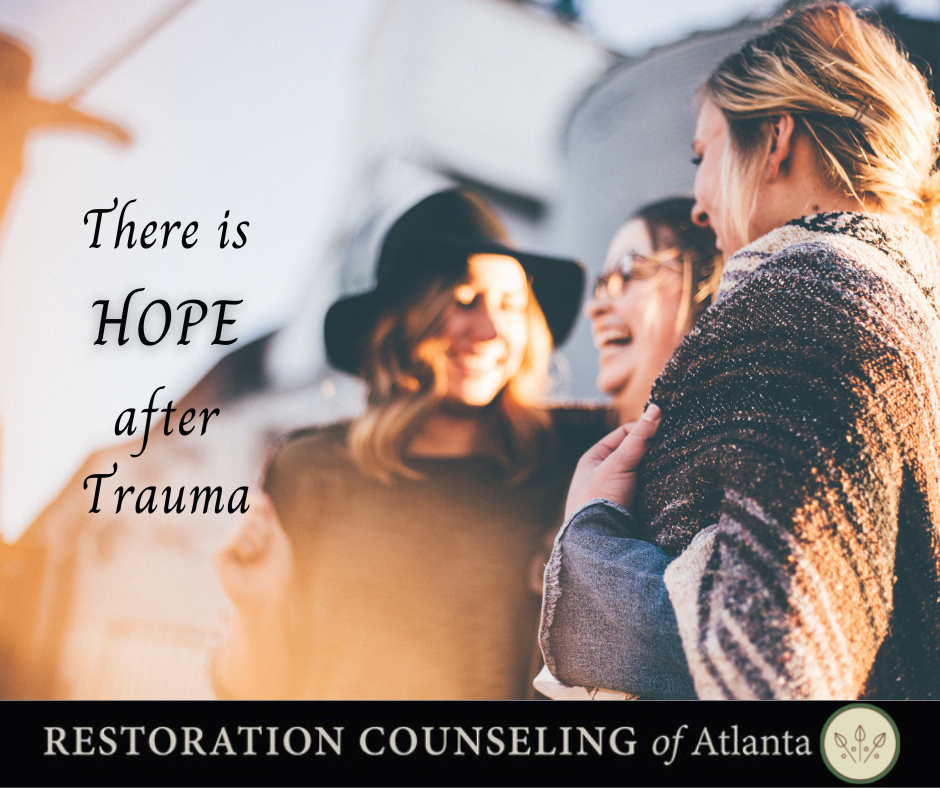I have found myself in several conversations recently, both with clients and friends, where the other person has implied that trauma, being traumatized, or having PTSD are labels that, once they are on, are never coming off. That there is no hope after trauma. How hopeless would it be if traumatic experiences always held power over people?
Thankfully, that is not how trauma works. I would not be a trauma therapist if this were the case! Friends: you can heal. There is hope after trauma.
With my clients, I utilize the three-stage approach to trauma treatment laid out by psychiatrist Judith Herman in her book Trauma and Recovery. Below are the three stages, and I’ve outlined how I navigate each one to engage clients in a journey toward hope and healing.
Safety and Stabilization
Traumatized clients often come to therapy with PTSD-like symptoms, such as flashbacks, nightmares, avoidance of memories of the traumatic event, negative beliefs about self, others, or the world, hypervigilance, and an inability to concentrate.
Before diving into the painful memories themselves, I work with clients on feeling relief from these symptoms. I help my clients teach their bodies that they don’t need to be in fight-or-flight mode all the time and teach their brains that they can rest. I regularly talk about filling up a client’s toolbelt with grounding techniques for them to try outside of sessions, and at the start of treatment, I often teach one new technique each session.
Trauma takes away people’s autonomy, so it is important to show my clients that in our sessions, they are in control. Giving my clients choices in everything we do allows them to know that what they want matters. I allow them to have a voice, ask questions, and disagree with me. I do everything I can to embody the opposite characteristics of trauma and provide a therapeutic experience. This helps clients stabilize and feel safe enough to move on to stage 2.
Remembrance and Mourning
This is often the stage people want to start with. The trauma symptoms described above are painful, and diving into the memories seems like the logical way to “get over” them. However, without knowing how to stabilize yourself, it can be re-traumatizing to discuss the trauma memories.
Once clients have the tools to stabilize themselves inside and outside of sessions and demonstrate the ability to utilize those tools positively, we start incorporating and re-processing the trauma. I often use a form of therapy called EMDR to help at this point; however, other trauma-informed tools also assist in remembering and mourning the memories and sensations elicited by the trauma.
Human brains have a fascinating feature called neuroplasticity. This, in an oversimplified definition, means that the brain is “plastic,” moldable, or flexible. The brain can change its structure, its functions, and the connections it makes. This is partially why memories can go from feeling upsetting to feeling neutral.
A therapy phrase I believe is accurate is, “You have to feel it to heal it.” Sitting in the memories, mourning the trauma, and knowing how to calm down if that gets overwhelming shows your brain that you will be okay and your defenses don’t need to engage. Once you feel the trauma in this safe, compartmentalized way, the neuroplasticity in the brain enables new connections to form.
Acceptance and Reconnection
In this third and final stage, the memories usually don’t feel as powerful as they previously did. This can look different for everyone, from acceptance of the events to indifference, from feeling empowered to feeling calm. Perhaps lessons have been learned, and consequences left behind. Perhaps there are fewer tears, but still deep emotion when reflecting on the trauma.
Any negative beliefs you previously held about yourself, such as not being good enough, feeling worthless, or the trauma being your fault, are gone and replaced with positive beliefs that feel true. Internally, you are integrated. There isn’t a part of your life that you have to mentally cut off and not think about.
Humans have an amazing capacity for resilience, in part due to resources like the brain’s neuroplasticity. We are ever-growing creatures made in the image of a beautiful God. We can learn to re-process traumatic events, tolerate distress, focus on strengths, and feel empowered. You can heal, and there is so much hope! If you would like to learn more about how this trauma recovery process could work for you, please reach out to me at hannah@restorationcounselingatl.com.

![]() Written by Hannah Clark, MA, APC
Written by Hannah Clark, MA, APC
hannah@restorationcounselingatl.com, ext. 122
Roswell and Woodstock locations
Hannah’s philosophy is that counseling is for everyone. Just like we take our cars to get the oil changed, mental health works the same way. The check engine light comes on, and we need to take a look under the hood. Hannah enjoys counseling individuals age 18 and up. She utilizes EMDR therapy to help with trauma and PTSD. She also sees individuals for issues such as grief, depression, anxiety, boundaries, life transitions, and spiritual or emotional abuse. Hannah previously worked for a college ministry and enjoys helping college students and women in (or formerly in) ministry.

